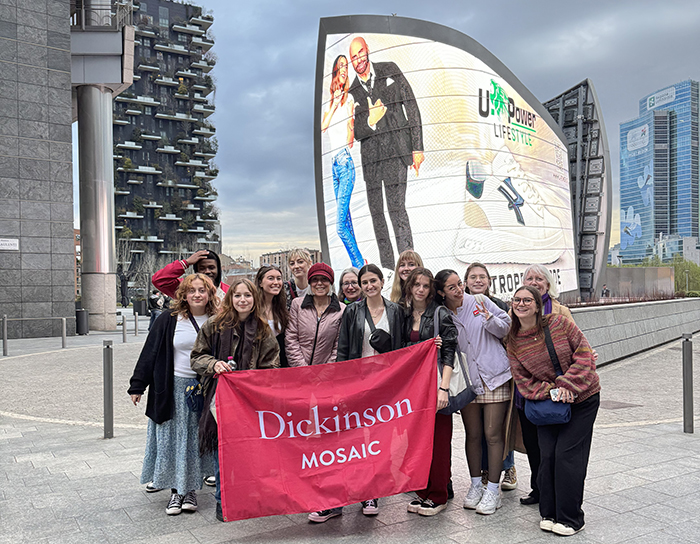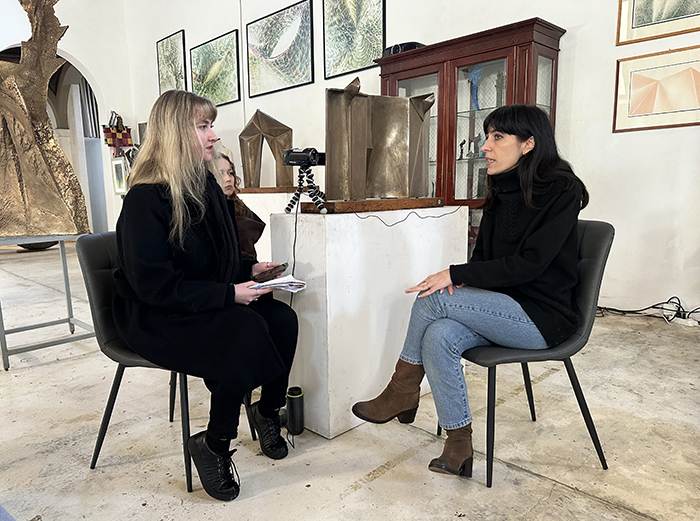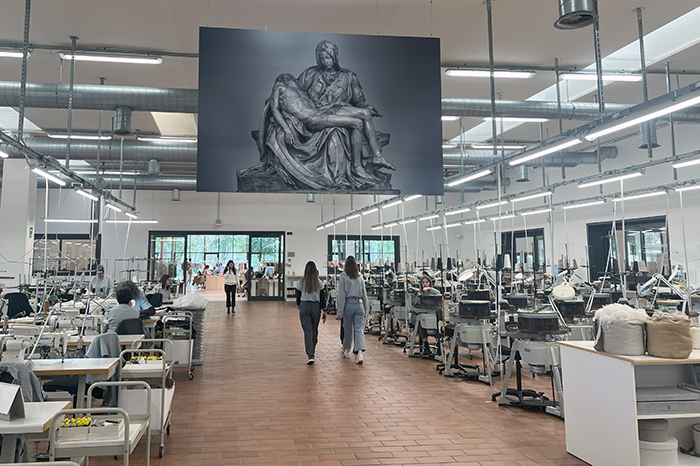The (Red) Devil Wears Prada

Students in Dickinson's spring 2024 Mosaic pose in Milan during their research trip to Italy.
Students research fashion culture in Italy
by MaryAlice Bitts-Jackson
"Fashion is instant language,” Miuccia Prada reportedly declared. And that language carries potent cultural and social messages, which a group of Dickinson students have learned to decode.
The students are enrolled in Dickinson's spring 2024 Mosaic, a semesterlong, immersive experience that focuses on a single, complex topic. After learning about different dimensions of fashion culture, the students traveled to Italy together to gain fresh insights on what fashion and fashion systems can tell us about history, culture, identity, politics, gender, race and economic systems and ways of life.
“It was incredibly eye-opening,” says Sofia-Teresa DiBacco ’26, a double major in political science and Italian studies.
Fast-paced and multifaceted
The Mosaic, Fashioning the Body, Shaping the Nation, corrals four interrelated courses. Nicoletta Marini Maio, professor of Italian and film studies, teaches a Mosaic class on fashion as a cultural dimension, industry and indicator of social change. Amy Farrell, professor of American studies and women’s, gender & sexuality studies, leads Fashion and the Politics of the Body. Associate Professor of History Regina Sweeney teaches Post-Renaissance Fashion. Students also take an independent-study class tailored to their research interests.
While learning about fashion and Italian culture from different vantage points, the students also sharpened their interviewing, video and audio-recording skills. Then, last month, they put their new skills and knowledge to the test in Milan, Bologna, Ferrara, Florence, Prato, Perugia and Rome.
“It was new and challenging to be a field researcher in a different country,” says Jordan Codispoti ’25 (history). “We visited so many different cities at a very fast pace.”

The students interviewed Italians working in different facets of the fashion system.
‘Entirely opposing views’
Throughout the three-week research trip, the students worked in multilingual teams. They interviewed designers, small-business owners, a brand strategist, fashion students and Chinese immigrants working in the garment industry. They also interacted with salespersons, foundation and museum staff, fat-acceptance activists and consumers. Along the way, they visited sites related to fashion history, culture, manufacturing, education and sales.
“Each city we visited had its own local culture surrounding fashion,” writes Bella Lapp ’26 (anthropology) in a post for the Mosaic’s blog, “and during interviews, the group spoke to many people who had entirely opposing views on fashion and art.”
What ‘made in Italy’ means

Students visit a factory in Solomeo.
Now back on campus, the students are analyzing their findings and composing multimedia presentations to convey what they’ve discovered. They’ll share their research during an on-campus presentation.
Inspired by a visit to Armani Studios and by interviews with an award-winning designer and coop workers and directors who create environmentally sustainable pieces, Anna Radigan '26 (art & art history), Roma Cervino '27 and Ady Salvatierra '26 (women's, gender & sexuality studies) are researching the intersection of upcycling, recycling and art.
Codispoti's research focuses on the enduring theme of family in Italian fashion lore and the ways that smaller brands challenge that narrative. Her work includes an exploration of what it means to be an Italian family—a question she formed after speaking with Chinese immigrants working in the fast-fashion industry in Prato. As a result of those conversations, she’s become more mindful of the origins of the goods she buys.
DiBacco, whose research contextualizes "Made in Italy" branding, was also moved by her brush with the fast-fashion sector. “It completely changed my perspective on how we should live in order to help our planet and to help others who are exploited,” she says.
DiBacco and Codispoti add that it’s both helpful and gratifying to share insights like these with fellow students across different majors, who bring unique perspectives to the far-reaching topic. “We all come from so many different backgrounds, organizations and majors, but we were all able to navigate the complicated and nuanced world of fashion together,” Codispoti says.
Learn about upcoming Mosaics focused on Ghana and France.
TAKE THE NEXT STEPS
Published July 5, 2024